Crypto Stock Valuation Guide: From NAV to mNAV, Understanding the Wealth Logic Behind Crypto-Stock Linkage
Original Title: 《Popular Science: How to Use NAV to Evaluate How Much Your Crypto Stocks Are Worth?》
Original Author: Deep Tide TechFlow
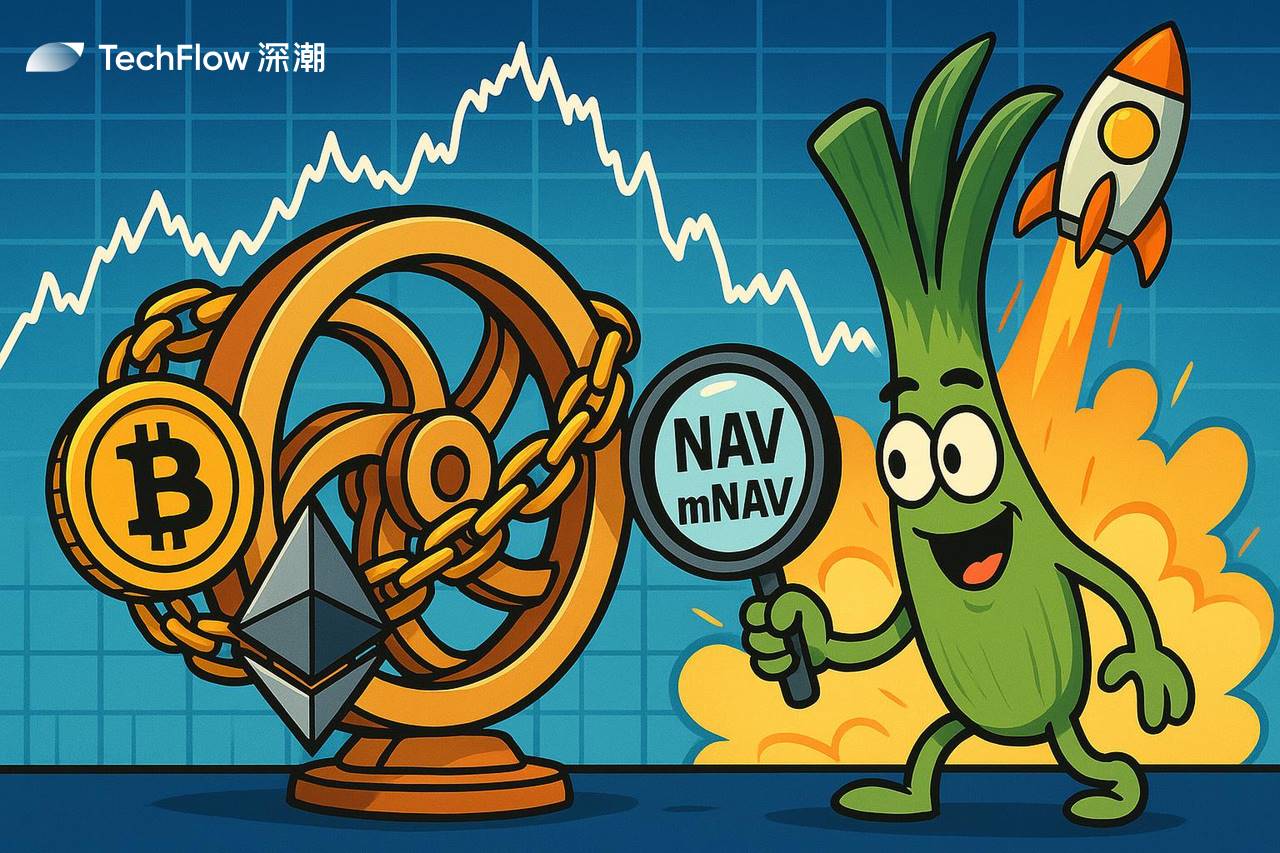
There is no doubt that this round of crypto bull market started first in US stocks.
When "crypto treasury reserve strategy" becomes the trendsetter in US stocks, and coins and stocks are linked, how should we evaluate the quality of a stock? Should we look at who has a larger amount of crypto assets in reserve, or who has the money to keep buying crypto assets?
If you have been frequently following the analysis of crypto US stocks recently, then you should frequently see a term appearing repeatedly --- NAV, which stands for Net Asset Value.

Some people use NAV to analyze whether crypto stocks are overvalued or undervalued, while others use NAV to compare the stock price of a new crypto reserve company with that of MicroStrategy; but the more critical wealth code lies in:
A publicly listed company in the US stock market that implements a crypto reserve strategy, holding $1 of cryptocurrency, its value is greater than $1.
These companies with crypto asset reserves can continue to increase their assets or buy back their own stocks, causing their market value to often far exceed their NAV (Net Asset Value).
But for the average retail investor, most projects in the crypto circle rarely use serious indicators for evaluation, let alone use them to evaluate the value of stocks in the traditional capital market.
Therefore, the editor also plans to do a popular science on the NAV indicator to help players who pay attention to the linkage between coins and stocks better understand the operation logic and evaluation methods of coin stocks.
NAV: How Much Is Your Stock Really Worth?
Before delving into crypto US stocks, we need to first clarify a basic concept.
NAV is not an indicator specifically designed for the crypto market, but one of the most common methods for measuring company value in traditional financial analysis. Its essential role is to answer a simple question:
"How much is a share of a company really worth?"
The calculation method of NAV is very straightforward, that is, the value that shareholders can get per share after subtracting the company's liabilities from its assets.
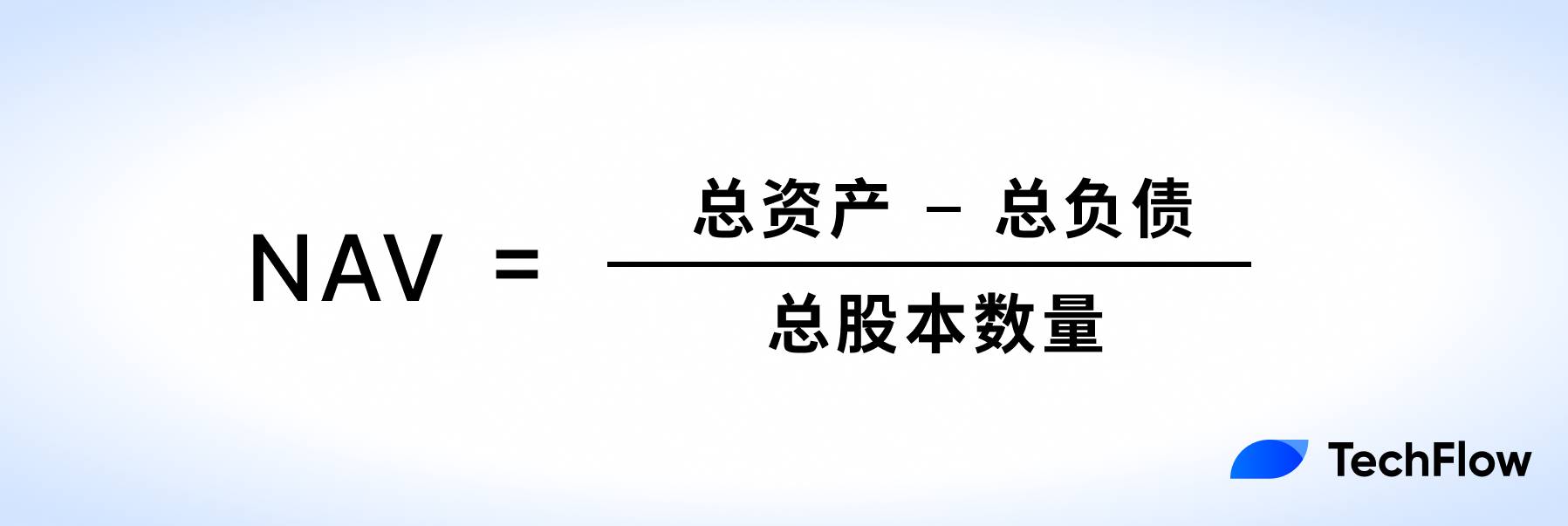
To better understand the core logic of NAV, we can use a traditional example to illustrate. Suppose there is a real estate company with the following financial situation:
Assets: 10 buildings, with a total value of $1 billion; Liabilities: $200 million in loans; Total Equity: 100 million shares.
Then the net asset value per share of this company is: $80/share. This means that if the company liquidates its assets and pays off all its debts, the holder of each share of stock can theoretically get $80.
NAV is a very universal financial indicator, especially suitable for asset-driven companies, such as real estate companies, investment fund companies, etc. The assets owned by these companies are usually relatively transparent, and the valuation is relatively easy, so NAV can well reflect the intrinsic value of their stocks.
In the traditional market, investors usually compare NAV with the current market price of the stock to judge whether a stock is overvalued or undervalued:
If stock price > NAV: The stock may have a premium, and investors are confident in the company's future growth potential;
If stock price < NAV: The stock may be undervalued, the market lacks confidence in the company, or there is uncertainty in the valuation of assets.
When NAV is applied to crypto US stocks, its meaning has undergone some subtle changes.
In the field of crypto US stocks, the core role of NAV can be summarized as:
Measuring the impact of the crypto assets held by a publicly listed company on its stock value.
This means that NAV is no longer just the traditional "assets minus liabilities" formula, but needs to specially consider the value of the cryptocurrency assets held by the company. The price fluctuations of these crypto assets will directly affect the company's NAV and indirectly affect its stock price.
For companies like MicroStrategy, the calculation method of NAV will particularly emphasize the value of its Bitcoin holdings, because these assets account for the vast majority of the company's total assets.
So the above calculation method is slightly extended:
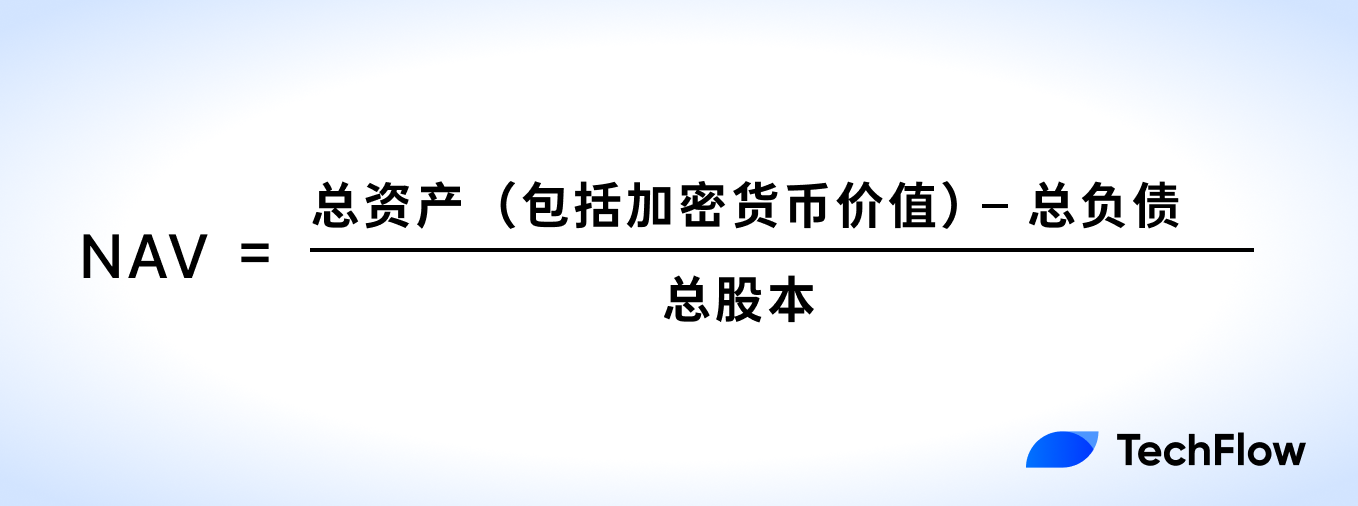
When crypto assets are added to the calculation of NAV, some changes you have to consider are:
The volatility of NAV increases significantly: Due to the violent price fluctuations of cryptocurrencies, NAV is no longer as stable as real estate or fund assets in the traditional market.
The value of NAV is "amplified" by crypto assets: Crypto assets usually get a premium in the market, which means investors are willing to pay a price higher than their book value to buy related stocks. For example, a company holds $100 million in Bitcoin assets, but its stock price may reflect the market's expectation of Bitcoin's future appreciation, causing the company's market value to reach $200 million.
When the market is bullish on the future price of Bitcoin, the company's NAV may be given additional premium by investors; conversely, when market sentiment is low, the reference value of NAV may decline.
If you still don't understand NAV, let's take MicroStrategy as an example.
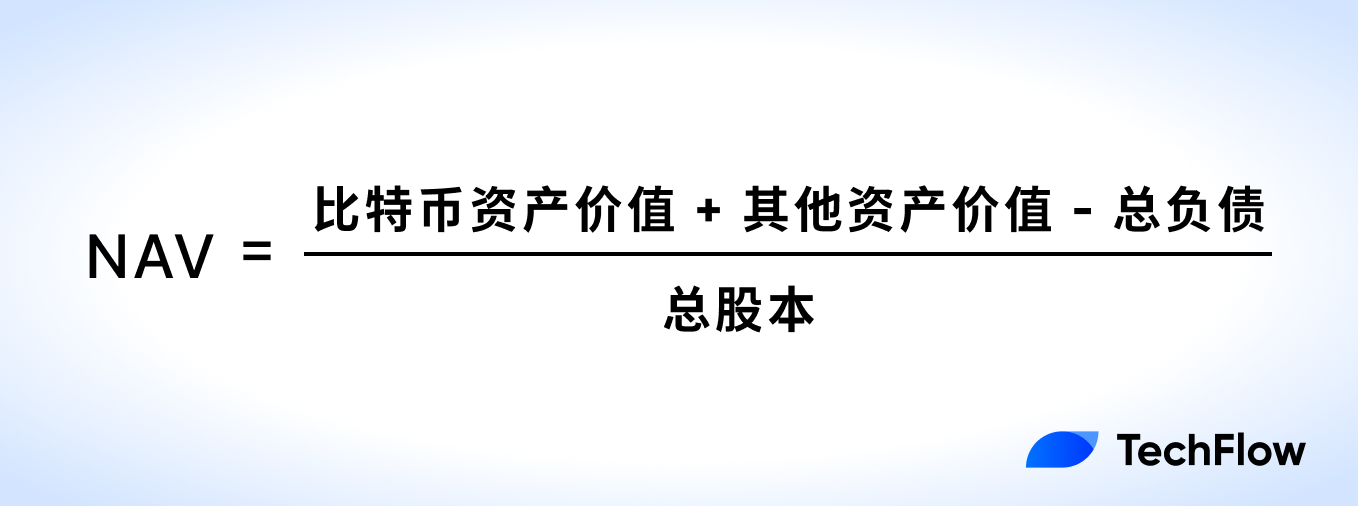
As of the time of writing (July 22), public data shows that MicroStrategy holds 607,770 Bitcoins, with a current price of $117,903, the total value of Bitcoin assets is about $72 billion, other assets are about $100 million, and the company's liabilities are $8.2 billion.
MicroStrategy's total equity is about 260 million, according to the above calculation its NAV is about $248/share. That is to say, with BTC as a crypto reserve, a share of MicroStrategy should be worth $248.
However, in the last US stock trading day, MicroStrategy's actual stock price was $426.
This reflects the market premium, that is, if the market believes that Bitcoin will rise in the future, then investors will factor this expectation into the stock price, making it much higher than NAV.
This premium reflects that NAV cannot fully capture the market's optimistic expectations for crypto assets.
mNAV: The Emotional Thermometer of Crypto US Stocks
In addition to NAV, you can often see some analysts and KOLs talking about another similar indicator --- mNAV.
If NAV is the basic indicator to measure how much a share is really worth, then mNAV is a more advanced tool that fits the dynamics of the crypto market.
As mentioned earlier, the focus of NAV is to reflect the current net asset (mostly crypto assets) status of the company, without involving the market's expectations for these assets; while mNAV is a more market-oriented indicator, used to measure the relationship between the company's market value and the net value of its crypto assets. Its calculation formula is:

Here, "net value of crypto assets" refers to the value of the cryptocurrency assets held by the company minus the related liabilities.
We can use a table to clearly compare the differences between the two indicators:
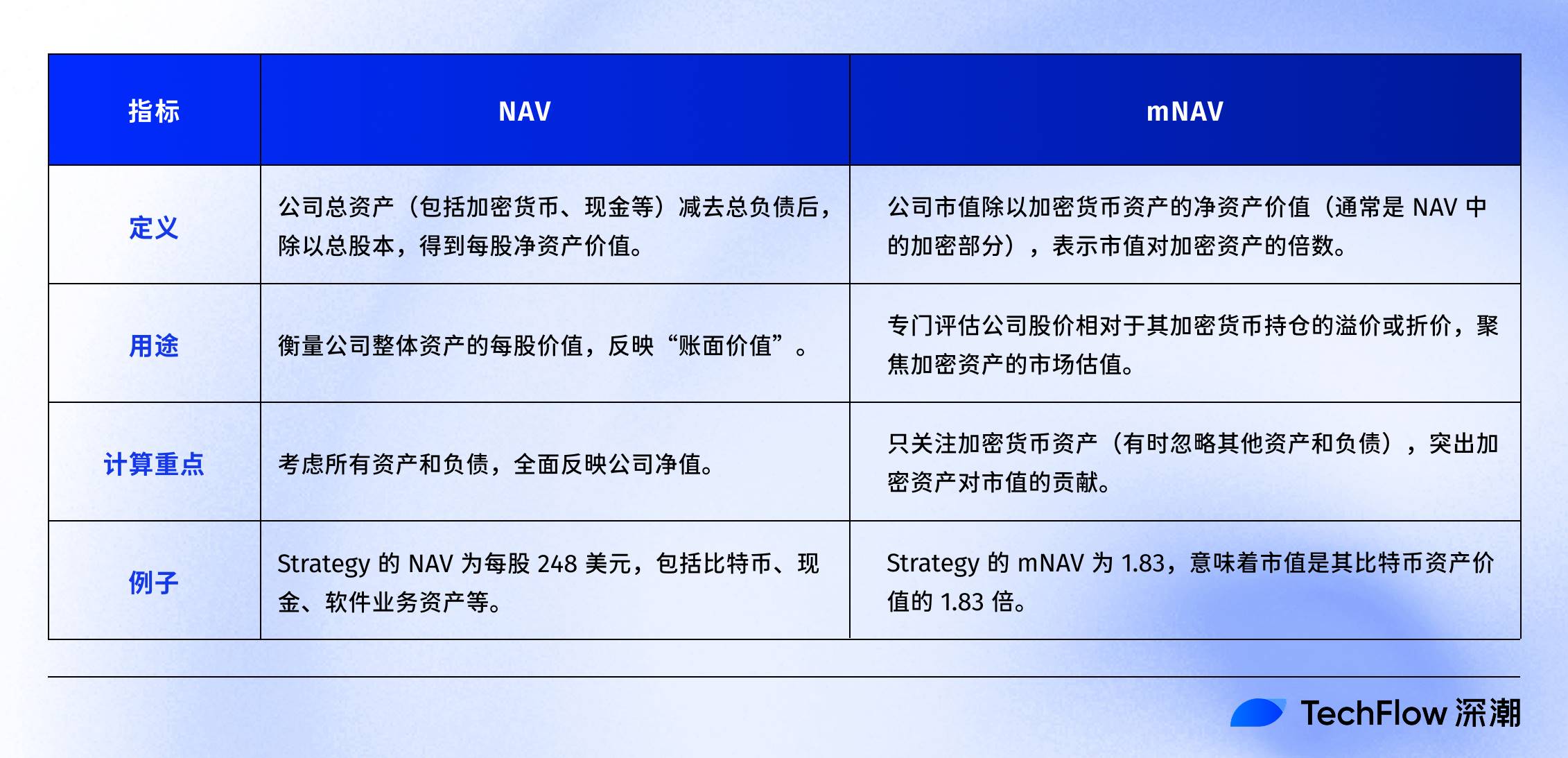
Similarly, according to the previous calculation, the total market value of MicroStrategy's stock is about $120 billion, and the net value of the BTC held (crypto assets + other company assets - liabilities) is about $63.5 billion, then its mNAV is about 1.83.
That is to say, MicroStrategy's market value is 1.83 times the value of its Bitcoin assets.
Therefore, when a company holds a large amount of cryptocurrency assets, mNAV can better reveal the market's expectations for these assets, reflecting the premium or discount of investors on the company's crypto assets; for example, in the above example, MicroStrategy's stock price is 1.83 times higher than its crypto net assets.
For short-term investors who pay attention to market sentiment, mNAV is a more sensitive reference indicator:
When the price of Bitcoin rises, investors may be more optimistic about the future performance of crypto asset-driven companies. This optimism will be reflected through mNAV, causing the company's stock market price to be higher than its book value (NAV).
mNAV higher than 1 indicates that the market has a premium on the value of the company's crypto assets; mNAV lower than 1 means that the market lacks confidence in the company's crypto assets.
Premium, Reflexivity Flywheel, and Death Spiral
As mentioned earlier, the current mNAV of MicroStrategy is about 1.83;
And when ETH is increasingly becoming the asset reserve of listed companies, understanding the mNAV of these companies also has certain reference significance for identifying whether the corresponding US stocks are overvalued or undervalued.
Analyst @Jadenn n3 26 eth from Cycle Trading has compiled a fairly detailed table, intuitively showing the asset and liability situation of the main ETH reserve companies and their mNAV values (data as of last week).
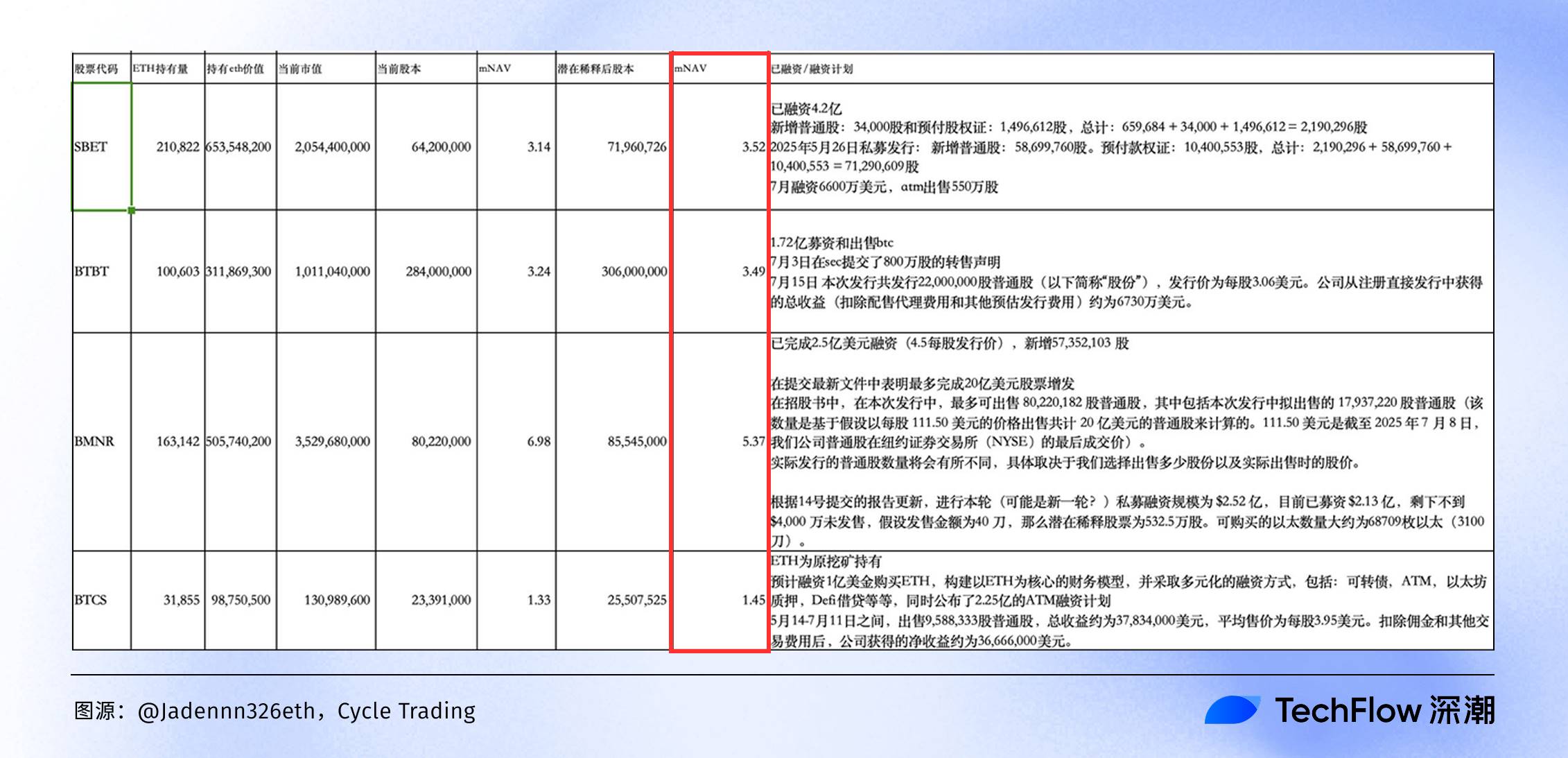
(Source: @Jadenn n3 26 eth, Cycle Trading)
From this ETH reserve company mNAV comparison chart, we can see at a glance the "wealth map" of the coin-stock linkage in 2025:
BMNR ranks first with a mNAV of 6.98 times, its market value far exceeds the value of its ETH holdings, but this may hide the bubble of overvaluation—once ETH adjusts, the stock price will also be the first to be damaged. And BTCS has only 1.53 times mNAV, relatively speaking, the premium is lower.
Since we have seen the data of these companies, we have to talk about "Reflexivity Flywheel".
This concept originates from the reflexivity theory of financial tycoon Soros, and in the 2025 bull market of coin-stock linkage, it has become the "secret engine" for the soaring stock prices of these companies.
Simply put, the reflexivity flywheel is a positive feedback loop: The company first issues stocks or ATM (At-The-Market) financing, exchanges for cash to buy ETH in large quantities; the increase in ETH holdings pushes up NAV and mNAV, attracting more investors to chase, and the stock price soars; the higher market value makes it easier for the company to refinance, continuing to increase ETH holdings... In this way, a self-reinforcing, snowball-like flywheel effect is formed.
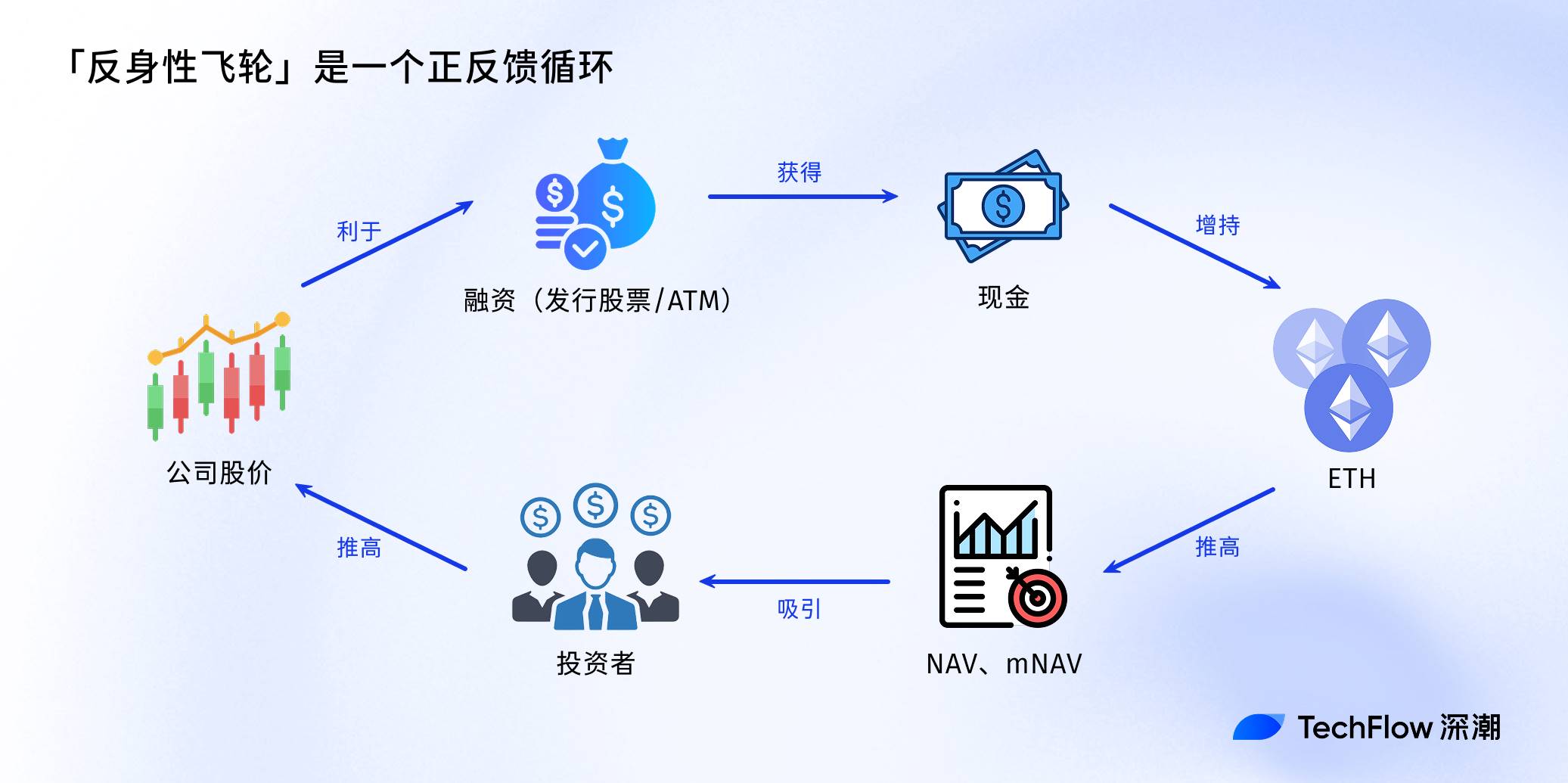
And once the price of ETH adjusts, regulations tighten (such as the SEC's review of the crypto reserve model) or financing costs soar, the ascending flywheel may reverse into a death spiral: The stock price collapses, mNAV plummets, and the last to be hurt may also be the retail investors in the stock market.
Finally, after reading this, you should understand:
NAV and other indicators are not panaceas, but sharp tools in the toolbox.
When players chase the linkage between coins and stocks, they should combine the macro trends of Bitcoin/Ethereum, the company's debt level and growth rate for rational evaluation, in order to find their own opportunities in the new cycle that seems to be full of opportunities but is actually dangerous.
Original link
